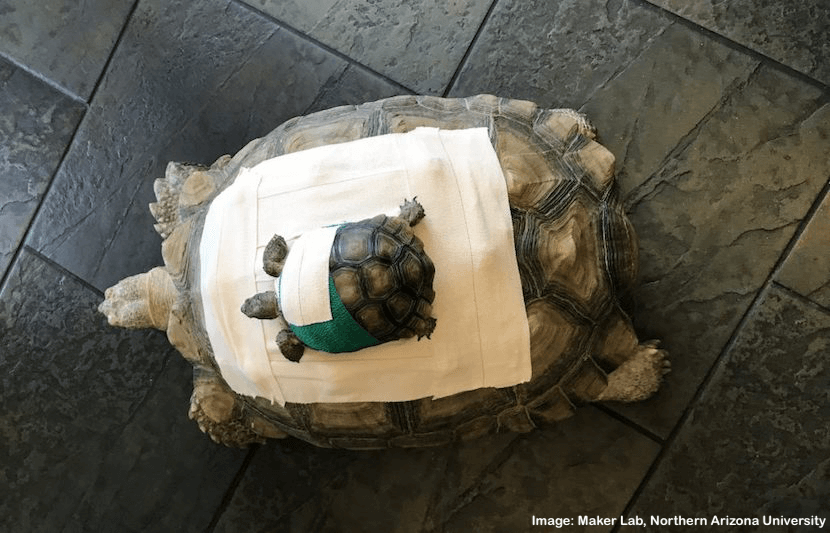As 3D printing has taken off in recent years, creative researchers have found more and more ways to apply the technology to create life-changing devices and groundbreaking devices — from printing electronics directly onto human skin to developing “smart” sensors that can be embedded into jet engines and creating low-cost bionic limbs for children born without arms.
Now, the Maker Lab at Northern Arizona University’s Cline Library has partnered with Tereza DeMuth, a veterinarian at nearby Canyon Pet Hospital, to create implants for damaged tortoise shells.
The NAU team — David Van Ness, an art professor and the director of the New Media Art Program at NAU, Kathleen Schmand, director of development and communications at Cline Library, and Andrew See, the head of user services for the library — was able to create prosthetic fixes for two tortoises whose shells had suffered serious damages, so they could survive.
Daisy, a 75-pound tortoise, was injured in a car accident that left two holes in her shell, leaving her exposed to infection and potential spine damage.
Tim, a 1.5-pound Mojave desert tortoise, had been bitten by a dog. The incident damaged his shell, leaving his liver dangerously exposed.
“Both tortoises were at high risk of infection and sepsis and so had to endure bandage changes every three days for about two months before the wounds were clean and healthy enough to cover with implants,” DeMuth said in a statement.
Each tortoise’s injury presented a unique challenge for the team as they sculpted the prosthetics.
For Daisy, the NAU team had the original pieces of her shell that had come off in the accident, so they were able to take these pieces and directly scan and model a prosthetic after them.
After Van Ness ran laser scans of the broken shell pieces and then tweaked the designs with a program called ZBrush. It took a few tries and a couple of different scans to create a prosthetic that fit well.
After the first print, they learned they were missing a piece and so had to rescan and reprint.
“It’s really that process of prototyping—printing out what you think is going to work and then actually measuring it against the reality and adjusting it,” Schmand said in a statement.
Tim’s injury presented a host of other challenges. Because they didn’t have a broken piece to scan, Van Ness had to freeform a design. Additionally, the library’s structured light scanner did not provide a high enough resolution, making it difficult to determine the exact shape and dimensions that would be necessary.
Van Ness considered using plasticine, an oil-based modeling clay to sculpt a prosthetic onto his shell and then use that as a model for the 3D printer. Luckily, Tim’s shell was healing quickly, so he needed only a temporary prosthetic — “a little bit of armor that can be left on for a shorter period of time,” as Schmand described in a statement.
“The most difficult part was finding the right material to print,” said DeMuth. “It had to be bio-friendly, cost-friendly, safe and durable to sterilize, and it had to be flexible so that it could grow with the tortoise as it ages or be easy to replace every year or so.”
“We wanted to use a biodegradable material called chitosan,” added Van Ness. “It’s a type of plastic made of group-up shrimp and crickets, similar to what fingernails and tortoise shells are made of. But it would have taken us a while to get the equipment.”
They settled on using polylactic acid (PLA), a biodegradable and environmentally friendly plastic material. PLA, commonly used for 3D printing, was the easy choice, as it was the material already used in all of the library’s printers.

The whole process cost only $20, a far cry from the hundreds of dollars that prosthetic fixes for tortoise shells typically cost.
The prosthetics will need to be replaced from time to time, as they will not grow with the tortoises. But at such a low cost, this represents only a small inconvenience.
The project shows the limitless potential of 3D printing, particularly within the medical field.
DeMuth said that veterinarians could use the technology to create everything from prosthetics to surgical implants to medical devices.
“Unlike in human medicine, our animal patients come in a very diverse range of shapes and sizes, so having the ability to create materials tailored to each unique individual makes this a very exciting time to be in veterinary practice,” she said in a statement.
As for Van Ness, he noted that he had previously worked with a company that used 3D printers for medical purposes.
“They printed bones with titanium, and those prints cost thousands of dollars,” he said. “I worked with a pair of twins that were connected to print bones they needed during and after the separation. We also had an Iraq War vet whose jaw we rebuilt. We printed a lattice structure, so as the bone regrows, it grows into that lattice and grabs onto the metal, and the metal slowly breaks apart.”
Furthermore, Van Ness noted, the development of these technologies is blurring the boundaries of art and science.
“For me, the arts are just applied sciences,” he said. “We do experiments, which is our artwork; we have labs, which are our studios. Part of me is always trying to disrupt the system a bit. That’s where innovation comes.”
“I’m currently working with biological 3D printers,” he continued. “I plan on printing biosensitive material and use cell samples to grow my own cells on my sculpture. I’m going to print a structure that’s bio-supportive, take a cheek swab and grow a culture on it.”
Whether helping Iraq War veterans or injured tortoises, the technology is changing lives. For the rest of her life, Daisy’s prosthetic implants will protect her from infection while allowing her to run around the yard like she did before the accident. Tim, meanwhile, will only have his cast until his shell finishes healing.



